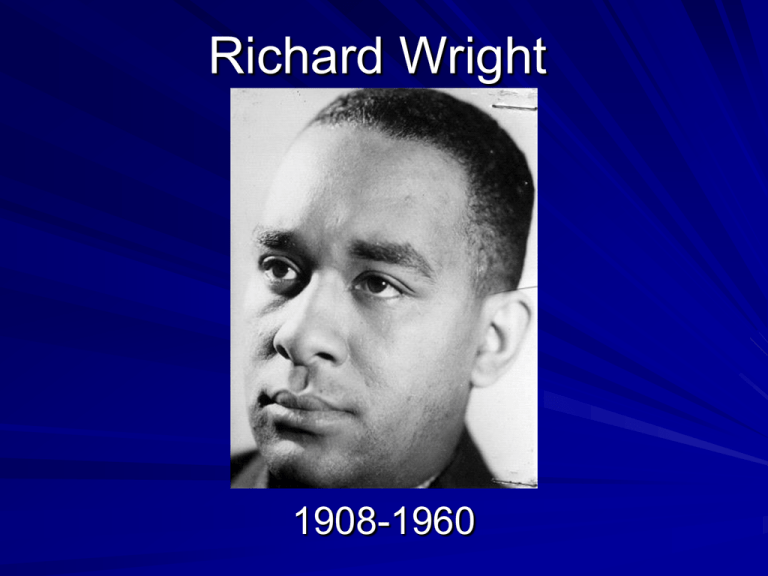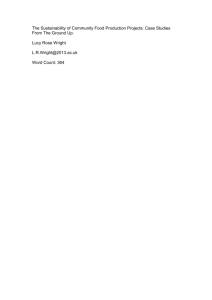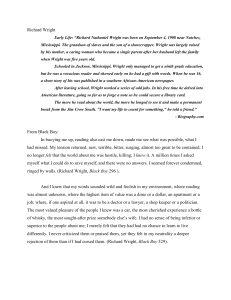Urban Naturalism
advertisement

Richard Wright 1908-1960 Biography Born on a plantation near Natchez, Mississippi, on September 4, 1908. Son of a sharecropper who deserted his family when Wright was 5. His mother became ill, and the family moved to Jackson, Mississippi with his grandmother. – Grandmother tried to stop Wright from writing. His grandmother attempted to crush his imagination. Biography Wright and his brother lived in an orphanage for a short time because of family problems. He would recall his childhood as a “time of hunger.” – For food, but also for affection, understanding, and education. Although a very good student, Wright never graduated from high school. Biography Wright’s jobs in the South were marked by harassment by whites and by his own disdain for what segregation and racism had done to distort the humanity of his fellow blacks, as he saw it. The harsh conditions of the South pushed Wright to his first exposure with Urban Naturalism. – Wright said he “could not read enough of them.” Urban Naturalism The term naturalism describes a type of literature that attempts to apply scientific principles of objectivity and detachment to its study of human beings. – Unlike realism, which focuses on literary technique, naturalism implies a philosophical position: For naturalistic writers, since human beings are, in Emile Zola's phrase, "human beasts," characters can be studied through their relationships to their surroundings. Urban Naturalism Key themes of Urban Naturalism: – Survival, determinism, violence, and taboo. – The "brute within" each individual, composed of strong and often warring emotions: – passions, such as lust, greed, or the desire for dominance or pleasure; – and the fight for survival in an amoral, indifferent universe. The conflict in naturalistic novels is often "man against nature" or "man against himself" – Characters struggle to retain a "veneer of civilization" despite external pressures that threaten to release the "brute within.“ – Example: Bigger Thomas – The forces of heredity and environment as they affect, and afflict, individual lives. Biography In 1927, Wright fled the South for Chicago. In Chicago, Wright seemed headed for a career in the post office but was also determined to become a writer. Wright found a circle of friends with similar views in 1933 when he joined the John Reed Club. – It was a nationwide organization founded by the communist party to attract writers and artists. Between 1933 and 1940 (the first major stage of his literary career), communism was clearly the major intellectual and political force of Wright’s life. Biography In 1938 four of his stories were collected as Uncle Tom’s Children. He then received a Guggenheim Fellowship, which allowed him to complete his first novel, Native Son (1940). In 1939, he married Dhimah Rose Meadman, a white dancer, but the two separated shortly thereafter. In 1941, he married Ellen Poplar, a white member of the Communist Party, and they had two daughters, Julia in 1942 and Rachel in 1949. Biography After moving to Paris in 1946, Wright became friends with Jean-Paul Sartre and Albert Camus while going through an Existentialist phase best depicted by his second novel, The Outsiders (1953). In his last years, he was plagued by illness (aerobic dysentary) and financial hardship. Throughout this period he wrote approximately 4,000 English Haikus (some of which were recently published for the first time) and another novel, The Long Dream, in 1958. After his death on November 28, 1960, another of his collections of short stories, Eight Men, was published. His most famous work is still his autobiographical work, Black Boy (1945). Themes and Goals of Native Son Major goal of Wright’s writing: – The exposure of the starkest realities of American life where race was concerned. Themes: – The effects of racism on the individual – Communism – Naturalism – Justice – The comforts of Religion Native Son This was meant to be America’s guide in confronting the danger of facing the profound consequences of more than two centuries of the enslavement and segregation of blacks in North America. Slavery and neo-slavery had led not simply to the development of a psychology of timidity, passivity, and even cowardice among African American masses. Wright suggests that it also gives rise to characters like Bigger Thomas. Bigger Thomas – These characters are estranged from both black and white culture through their hatred of both cultures, which gives rise to acts of violence. – These acts of violence were most often aimed at other African Americans, but Wright warned that one day it would be aimed at whites. Intellectual Forces Other than naturalism, two other intellectual forces came together to shape Native Son; communism and existentialism. Communism: – the political and economic doctrine that aims to replace private property and a profit-based economy with public ownership and communal control of at least the major means of production and the natural resources of a society. Existentialism Existentialism: – The Existentialist conceptions of freedom and value arise from their view of the individual. Since we are all ultimately alone, isolated islands of subjectivity in an objective world, we have absolute freedom over our internal nature, and the source of our value can only be internal. – Main principle: Existence precedes Essence. Existentialism To review the essential beliefs of French existentialists, consider the following ideas: 1. Existentialists believe in free will. 2. Existentialists do not recognize any human or immortal authority. – – Denied God’s existence in a cruel world, full of suffering. No Faith because no hope. 3. Existentialists believe that they are responsible for all the consequences of their actions. 4. Existentialists do not believe in an afterlife. 5. Sartre stated that we "are condemned to be free." 6. Camus stated that "life is absurd."





